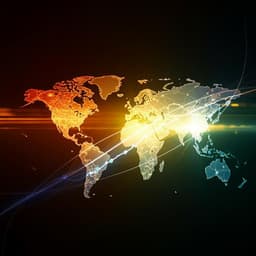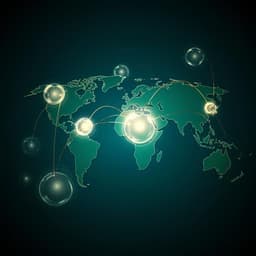
Environmental Studies and Forestry
Contributions of recycled wastewater to clean water and sanitation Sustainable Development Goals
C. Tortajada
This research by Cecilia Tortajada uncovers the transformative potential of recycled wastewater in achieving Sustainable Development Goals, particularly SDG 6 focused on clean water and sanitation. With global water scarcity rising due to various factors, innovative wastewater reuse emerges as a promising strategy to enhance water resources and sanitation.
~3 min • Beginner • English
Introduction
The paper frames potable water reuse within the Sustainable Development Goals, particularly SDG 6 to ensure availability and sustainable management of water and sanitation for all. It contrasts the MDGs’ limited focus on access without water quality and wastewater management with the SDGs’ explicit targets to reduce untreated wastewater by half and increase recycling and safe reuse. The introduction underscores the interdependence of clean water provision with sanitation and wastewater management, arguing that clean water is unattainable without proper collection, treatment, and disposal of wastewater. It details systemic constraints—political will, short-term planning horizons, limited managerial, financial and human capacity, weak governance, non-implementable legal/regulatory frameworks, inadequate data for decision-making, and poor intersectoral collaboration—that hinder progress. Pollution, in addition to scarcity, is emphasized as a key factor limiting safe water availability. The paper proposes that advancing SDG 6 through wastewater treatment and reuse can create new safe supplies, improve environmental quality, and strengthen institutional capacities, while noting enabling conditions such as education and gender equality.
Literature Review
The study synthesizes international assessments and regulatory reports to characterize global water quality challenges and the state of potable reuse. It references UN, UNICEF, UNEP, World Bank, and Global Burden of Disease sources illustrating rising pathogenic and organic pollution in Africa, Asia, and Latin America since 1990, and persistent inequalities in access within developed countries. U.S. EPA inventories show substantial proportions of assessed rivers and lakes failing standards, and national lake assessments indicating elevated nutrients. European Environment Agency reports document widespread hydromorphological pressures, non-point agricultural pollution, atmospheric deposition (notably mercury), and continuing nitrate exceedances leading to EU enforcement actions. The review also draws on reuse compendia and state-level guidance (e.g., California, Texas) outlining regulatory evolution for indirect and direct potable reuse, and case literature on projects in the U.S., Namibia, Singapore, Belgium, the UK, and South Africa. It highlights knowledge gaps on emerging contaminants (pharmaceuticals, microplastics), mixtures, and health/ecological effects that necessitate ongoing toxicological and epidemiological research and improved monitoring and risk assessment frameworks.
Methodology
The paper employs a three-part approach: (1) a literature review and analysis to map the range of issues determining the contribution of water reuse to SDG 6 and related SDGs; (2) examination of potable reuse projects with long operational histories to illustrate benefits for safe water and sanitation, alongside cases halted due to health concerns or insufficient public engagement; and (3) presentation of recent national-level initiatives (e.g., in the United States) aimed at strengthening and diversifying water resources, to emphasize water reuse’s role in achieving SDG targets.
Key Findings
- Global water quality has deteriorated markedly, constraining safe supplies: between 1990 and 2017, indicator deterioration reached 86% in Southeast/East Asia and Oceania, 58% in North Africa and the Middle East, and 56% in South Asia. Roughly 2 billion people rely on contaminated drinking water sources.
- In the U.S., 44% of assessed river and stream miles and 64% of assessed lake acres (2009) did not meet standards; a 2019 national lake assessment found ~20% with high phosphorus and nitrogen. Nevertheless, robust legal and institutional frameworks have facilitated improvements and enable potable reuse under the Safe Drinking Water Act and Clean Water Act, with state-level criteria advancing IPR and case-by-case DPR.
- In Europe, only 38% of surface waters and 43% of groundwater had status assessed by 2016; pressures include hydromorphology (60%), non-point pollution (38%, mainly agricultural), atmospheric deposition (38%), point sources (18%), and abstraction (7%). In England, only 14% of rivers meet minimum good status; nitrate exceedances persist (e.g., Germany).
- Potable reuse modalities: Indirect potable reuse (IPR) introduces advanced-treated recycled water into environmental buffers (reservoirs, rivers, aquifers) before conventional treatment; direct potable reuse (DPR) sends advanced-treated water to drinking water treatment and distribution without an environmental buffer.
- Demonstrated projects:
• Orange County, California: Groundwater Replenishment System (IPR) producing ~100 MGD (planned expansion to 130 MGD), serving ~850,000 people and preventing seawater intrusion; widely regarded as a benchmark.
• Texas (Big Spring, Wichita Falls): DPR implemented during drought as the only feasible option.
• California regulatory trajectory includes 1978 regulations (revised 2014), 2018 surface water augmentation criteria for IPR, and ongoing framework development for DPR.
• Windhoek, Namibia: DPR since 1968; during the 2015–2017 and 2019–2020 severe droughts, potable reuse increased to ~30% of supply, helping avert rationing.
• Singapore: NEWater launched 2003; currently meets ~40% of demand with plans for ~55% by 2060 via a mix of direct non-potable and indirect potable reuse, enabled by comprehensive public education and acceptance.
• Europe (examples): Wulpen, Belgium (IPR via aquifer recharge ~1.9 MGD); Essex, UK (IPR via upstream river return ~10.5 MGD). Decades of operation across projects have shown no documented adverse health effects.
- National initiatives: The U.S. EPA’s National Water Reuse Action Plan (Feb 2020) seeks to enhance water security, sustainability, and resilience through reuse, addressing policy, programmatic, science, and technology gaps via cross-sector collaboration.
- Benefits of potable reuse: reliable new supplies, reduced pollutant discharges, protection of aquatic ecosystems, and advancement of technology and science. Challenges include health/environmental concerns, knowledge gaps on monitoring (including emerging contaminants), psychological barriers, and ensuring technical, managerial, and financial viability.
- Technical assurance: Advanced treatment trains (e.g., membranes, UV) with robust, continuous monitoring, auditing, and risk-based drinking water safety plans can deliver water often cleaner than many river sources, especially where wastewater is inadequately treated.
- Alignment with SDGs: Potable reuse supports SDG 6 by augmenting safe supplies and improving sanitation, with particular value during droughts; however, it must be embedded in holistic water planning and governance to realize broad quality-of-life improvements.
Discussion
The findings support the central proposition that advanced-treated recycled wastewater can be a significant, safe, and resilient source of potable supply, directly addressing SDG 6 targets to improve water quality, reduce untreated discharges, and increase recycling and safe reuse. Case studies demonstrate technical feasibility, regulatory pathways, and public acceptance strategies, particularly where scarcity and pollution are acute. The documented absence of adverse health outcomes in long-running schemes, coupled with stringent multi-barrier treatment and risk management, reinforces the viability of potable reuse. At the same time, the paper emphasizes that potable reuse is not a panacea; enduring progress requires robust institutions, enforceable and practical regulations, comprehensive monitoring (including real-time and independent auditing), and sustained public engagement. Addressing emerging contaminants through toxicological and epidemiological research and adaptive regulation is essential to maintain public health protection and confidence. Integrating potable reuse within broader, holistic water resource management—alongside demand-side measures, source control, watershed protection, and intersectoral coordination—maximizes contributions to SDG 6 and related goals (health, environment, resilience), especially for vulnerable populations.
Conclusion
Recycled wastewater, when advanced-treated and properly governed, can materially contribute to clean water and sanitation by augmenting potable supplies, improving environmental water quality, and enhancing drought resilience. International experiences (U.S., Namibia, Singapore, Belgium, UK) illustrate durable benefits and provide regulatory and operational templates. Achieving SDG 6 will require embedding potable reuse within comprehensive water planning and management, strengthening institutional capacity, and ensuring continuous, transparent monitoring and public engagement. Future research and policy priorities include closing knowledge gaps on emerging contaminants and mixtures; enhancing real-time monitoring and data analytics; refining risk assessment for vulnerable groups; developing uniform, health-protective DPR criteria; advancing engineered buffers and fail-safes; and scaling public education to overcome psychological barriers. These steps can expand safe reuse while safeguarding public health and ecosystems.
Limitations
The paper is a narrative synthesis based on secondary sources and selected case studies; it does not present new empirical measurements, quantitative comparative effectiveness analyses, or comprehensive global datasets. Regional and project examples, while illustrative, may not generalize across differing institutional and environmental contexts. The discussion acknowledges persistent data limitations in many countries (e.g., incomplete monitoring, inconsistent enforcement), and highlights unresolved uncertainties regarding emerging contaminants, mixture effects, and risk profiles for vulnerable populations.
Related Publications
Explore these studies to deepen your understanding of the subject.







